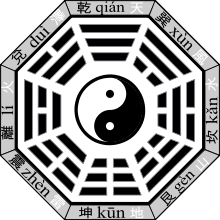A binary code represents text or computer processor instructions using the binary number system's two binary digits, 0 and 1.
The modern binary number system, the basis for binary code, was discovered by Gottfried Leibniz in 1679 and appears in his article Explication de l'Arithmétique Binaire.
Leibniz encountered the I Ching through French Jesuit Joachim Bouvet and noted with fascination how its hexagrams correspond to the binary numbers from 0 to 111111, and concluded that this mapping was evidence of major Chinese accomplishments in the sort of philosophical mathematics he admired.
Binary systems predating Leibniz also existed in the ancient world. The aforementioned I Ching that Leibniz encountered dates from the 9th century BC in China.[6] The binary system of the I Ching, a text for divination, is based on the duality of yin and yang.[7] Slit drums with binary tones are used to encode messages across Africa and Asia.[7] The Indian scholar Pingala (around 5th–2nd centuries BC) developed a binary system for describing prosody in his Chandashutram.
In 1605 Francis Bacon discussed a system whereby letters of the alphabet could be reduced to sequences of binary digits, which could then be encoded as scarcely visible variations in the font in any random text.

The I Ching ([î tɕíŋ] or Classic of Changes, is an ancient divination text and the oldest of the Chinese classics. Possessing a history of more than two and a half millennia of commentary and interpretation, the I Ching is an influential text read throughout the world, providing inspiration to the worlds of religion, psychoanalysis, business, literature, and art.
The I Ching uses a type of divination called cleromancy, which produces apparently random numbers. Four numbers, 6 to 9, are turned into a hexagram, which can then be looked up in the I Ching book, arranged in an order known as the King Wen sequence
Cleromancy is a form of sortition, casting of lots, in which an outcome is determined by means that normally would be considered random, such as the rolling of dice, but are sometimes believed to reveal the will of God, or other supernatural entities.
Belomancy, also bolomancy, is the ancient art of divination by use of arrows. The word is built upon Greek βέλος belos, "arrow, dart" and μαντεία manteia "divination". Belomancy was anciently practised at least by Babylonians, Greeks, Arabs and Scythians.
The arrows were typically marked with occult symbols and had to have feathers for every method. In one method, different possible answers to a given question were written and tied to each arrow. For example, three arrows would be marked with the phrases, God orders it me, God forbids it me, and the third would be blank. The arrow that flew the furthest indicated the answer. Another method involves the same thing, but without shooting the arrows. They would simply be shuffled in the quiver, worn preferably on the back, and the first arrow to be drawn indicated the answer. If a blank arrow was drawn, they would redraw.
Rhabdomancy is a divination technique which involves the use of any rod, wand, staff, stick, arrow, or the like.
One method of rhabdomancy was setting a number of staffs on end and observing where they fall, to divine the direction one should travel, or to find answers to certain questions.[1][2]It has also been used for divination by arrows (which have wooden shafts) - otherwise known as belomancy.[3] Less commonly it has been assigned to the I Ching, which traditionally uses a bundle of yarrow shoots,[4] and also dowsing, which often uses a wooden stick
I find it interesting that a Jesuit and Francis Bacon were instrumental in getting divination /binary code to the western world. Now we are surrounded by this code and have no idea about its origins.
No comments:
Post a Comment